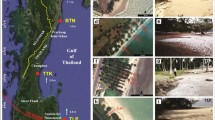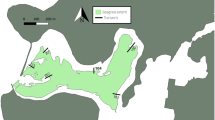Abstract
Excessive sedimentation in mountain stream ecosystems is a critical environmental problem due to the clogging of streambeds by sediment particles within the hyporheic zone, with detrimental effects on fish spawning habitat. In this research, the effects of an array of boulders in regulating the intrusion of incoming sand within a gravel substrate were evaluated by performing detailed experiments in a laboratory flume. A unique experimental setup and two different sampling techniques were utilized for measuring the infiltrated sand within the gravel bed under two bed shear stress conditions (moderate vs. high). For comparison purposes, experiments were performed without and with the presence of partially submerged to the flow (protruding) boulders, which is typical for the average flow conditions found in mountain streams. Results indicated that sand infiltrated primarily in the upper part of the gravel bed creating a surface seal which hindered the penetration of sand particles deeper into the bed. An exponential decrease of the amount of the infiltrated sand within the hyporheic zone was observed in all experiments regardless of the presence of boulders. However, the presence of boulders promoted sediment intrusion of sand particles especially for the moderate applied bed shear stress condition, since the total amount of the infiltrated sand was found to be on average 44% greater when boulders were present. The findings from this study can provide additional insight regarding the role of boulders on promoting downwelling of flow and sediment within the gravel substrate with potential effects on fish habitat.
Similar content being viewed by others
References
Alonso CV, Mendoza C, Tabios III GQ (1986) Sediment intrusion into the substrate of gravel bed streams. In: Conference Proceeding Water Forum’ 86: World Water Issues in Evolution. Long Beach, CA, USA, August 4–6, 1986.
Alonso CV, Theurer FD, Zachmann DW (1996) Sediment intrusion and dissolved-oxygen transport model-SIDO. United States Department of Agriculture, Technical Report No. 5, USDA-ARS National Sedimentation Laboratory, Oxford, MS, USA.
Beschta RL, Jackson WL (1979) The intrusion of fine sediments into a stable gravel bed. Journal of the Fisheries Research Board of Canada 36: 204–210. DOI: 10.1139/f79-030
Bjornn TC, Brusven MA, Molnau MP, et al. (1977) Transport of granitic sediment in streams and its effects on insects and fish. Bulletin 17, College of Forestry, Wildlife and Range Sciences, University of Idaho, Moscow.
Bouckaert FW, Davis J (1998) Microflow regimes and the distribution of macroinvertebrates around stream boulders. Freshwater Biology 40: 77–86. DOI: 10.1046/j.1365-2427.1998.00329.x
Boulton AJ, Findlay S, Marmonier P, et al. (1998) The functional significane of the hyporheic zone in streams and rivers. Annual Review of Ecology and Systematics 29: 59–81.
Brunke M, Gonser T (1997) The ecological significance of exchange processes between rivers and ground water. Freshwater biology 37: 1–33.
Carling PA (1984) Deposition of fine and coarse sand in an open-work gravel bed. Canadian Journal of Fisheries and Aquatic Sciences 41: 263–270. DOI: 10.1139/f84-030
Carling PA, McCahon CP (1987) Natural siltation of brown trout (Salmo trutta L.) spawning gravels during low flow conditions In: Craig JF, Kemper JB (Eds.), Regulated Streams, Plenum Publishing Corporation, New York, USA. pp 229–244.
Cienciala P, Hassan MA (2013) Linking spatial patterns of bed surface texture, bed mobility, and channel hydraulics in a mountain stream to potential spawning substrate for small resident trout. Geomorphology 197: 96–107. DOI: 10.1016/j.geomorph.2013.04.041
Cui Y, Wooster JK, Baker PF, et al. (2008) Theory of fine sediment infiltration into immobile gravel bed. Journal of Hydraulic Engineering, 134(10): 1421–1429.
Dermisis D, Papanicolaou AN (2007) Sand movement over gravel-bed with distinguishable isolated roughness elements, In: 32nd Congress of IAHR on Harmonizing the demand of Art and Nature in Hydraulics, Venice, Italy, 1–6 July 2007
Diplas P, Parker G (1984) Effects of fines in gravel streams behavior. In: Water for resource development.
Diplas P, Parker G (1985) Pollution of gravel spawning grounds due to fine sediment. St. Anthony Falls Hydraul. Lab. Proj. Rep. 240, University of Minnesota, Minneapolis, MN, USA. p 145.
Einstein HA (1968) Deposition of suspended particles in a gravel bed. Journal of Hydraulic Division 94: 1197–1205.
Elliott AH, Brooks NH (1997) Transfer of nonsorbing solutes to a streambed with bedforms: Laboratory experiments. Water Recourses Research 33: 137–151.
Ferreira RM, Ferreira LM, Ricardo AM, et al. (2010) Impacts of sand transport on flow variables and dissolved oxygen in gravel-bed streams suitable for salmonid spawning. River research and applications 26: 414–438. DOI: 10.1002/rra.1307
Franssen J, Lapointe M, Magnan P (2013) Geomorphic controls on fine sediment reinfiltration into salmonid spawning gravels and the implications for spawning habitat rehabilitation. Geomorphology. DOI: 10.1016/j.geomorph.2013.12.019
Fries JS, Trowbridge JH (2003) Flume observations of enhanced fine-particle deposition to permeable sediment beds. Limnology and Oceanography 48: 802–812. DOI: 10.4319/lo.2003.48.2.0802
Frostick LE, Lucas PM, Reid I (1984) The infiltration of fine matrices into coarse grained alluvial sediments and its implications for stratigraphical interpretation. Journal of the Geological Society 141: 955–965. DOI: 10.1144/gsjgs.141.6.0955
Garcia M (2008) Chapter 2, Sediment Transport and Morphodynamics. In Sedimentation Engineering, Processes, Measurements, Modeling, and Practice. Garcia MH (ed.), American Society of Civil Engineering, Reston, Virginia, USA. pp 21–163.
Ghidaglia C, Guazzelli E, Oger L (1991) Particle penetration depth distribution in deep bed filtration. Journal of Physics D: Applied Physics 24: 2111–2114. DOI: 10.1088/0022-3727/24/11/031
Greig SM, Sear DA, Carling PA (2005) The impact of fine sediment accumulation on the survival of incubating salmon progeny: Implications for sediment management. Science of the total environment 344: 241–258. DOI: 10.1016/j.scitotenv.2005.02.010
Heimerl S, Krueger F, Wurster H (2008) Dimensioning of fish passage structures with perturbation boulders. Hydrobiologia 609: 197–204. DOI: 10.1007/s10750-008-9414-0
Huang X, Garcia MH (2000) Pollution of gravel spawning grounds by deposition of suspended sediment. Journal of Environmental Engineering 126: 963–967. DOI: 10.1061/(ASCE)0733-9372(2000)126:10(963)
Huettel M, Ziebis W, Forster S (1996) Flow induced uptake of particulate matter in permeable sediments. Limnology and Oceanography 4l: 309–322. DOI: 10.4319/lo.1996.41.2.0309
Hutchinson PA, Webster IT (1998) Solute uptake in aquatic sediments due to current-obstacle interactions. Journal of Environmental Engineering 124: 419–426. DOI: 10.1061/(ASCE)0733-9372(1998)124:5(419)
Hynes HBN (1970) The ecology of running waters. University of Toronto Press, Toronto.
Joy DM, Lennox WC, Kouwen N (1993) Stochastic model of particulate transport in porous medium. Journal of Hydraulic Engineering 119: 846–851. DOI: 10.1061/(ASCE)0733-9429 (1993)119:7(846)
Kondolf GM, Wolman MG (1993) The sizes of salmonid spawning gravels. Water Recourses Research 29: 2275–2285. DOI: 10.1029/93WR00402
Lauck T, Lamberson R, Lisle TE (1993). A simulation model for the infiltration of heterogeneous sediment into a stream bed. In: Advances in Hydro-science and Engineering: Proceedings of the International Conference on Hydroscience and Engineering, Washington, DC, May.
Lawrence DSL (1997) Macroscale surface roughness and frictional resistance in overland flow. Earth Surface Processes and Landforms 22(4): 365–382.
Levasseur M, Berube F, Bergeron NE (2006) A field method for the concurrent measurement of fine sediment content and embryo survival in artificial salmonid redds. Earth Surface Processes and Landforms 31: 526–530. DOI: 10.1002/esp.1344
Lisle TE (1989) Sediment transport and resulting deposition in spawning gravels, North Coastal California. Water Resources Research 25: 1303–1319. DOI: 10.1029/WR025i006p01303
Morris HM (1955) Flow in rough conditions. Transactions of the American Society of Civil Engineers 120: 373–398.
Packman AI, Salehin M, Zaramella M (2004) Hyporheic exchange with gravel beds: Basic hydrodynamic interactions and bedform-induced advective flows. Journal of Hydraulic Engineering 130: 647–656. DOI: 10.1061/(ASCE)0733-9429(2004)130:7(647)
Papanicolaou AN, Dermisis DC, Elhakeem M (2011) Investigating the role of clasts on the movement of sand in gravel bed rivers. Journal of Hydraulic Engineering 137: 871–883. DOI: 10.1061/(ASCE)HY.1943-7900.0000381
Papanicolaou AN, Diplas P, Bala M, et al. (1999) Computer vision technique for tracking bed load movement. Journal of Computing in Civil Engineering 13: 71–79. DOI: 10.1061/(ASCE)0887-3801(1999)13:2(71)
Papanicolaou AN, Kramer CM, Tsakiris AG, et al. (2012) Effects of a fully submerged boulder within a boulder array on the mean and turbulent flow fields: Implications to bedload transport. Acta Geophysica. DOI: 10.2478/s11600-012-0044-6
Qian Q, Voller VR, Stefan HG (2008) A vertical dispersion model for solute exchange induced by underflow and periodic hyporheic flow in a stream gravel bed. Water Recourses Research 44. DOI: 10.1029/2007WR006366
Reiser DW (1998) Sediment in gravel bed rivers: ecological and biological considerations. In: Klingeman PC, Beschta RL, Komar PD, Bradley JB (eds.), Gravel-bed Rivers in the environment. Water Resources Publications, Colorado. pp 199–228.
Reiser DW, White RG (1988) Effects of two sediment size classes on survival of steelhead and chinook salmon eggs. North American Journal of Fisheries Management 8: 432–437. DOI: 10.1577/1548-8675(1988)008%3C0432:EOTSSC%3E2.3.CO;2
Rickenmann D (2001) Comparison of bed load transport in torrents and gravel bed streams. Water Recourses Research 37: 3295–3305. DOI: 10.1029/2001WR000319
Rusch A, Huettel M (2000) Advective particle transport into permeable sediments-evidence from experiments in an intertidal sandflat. Limnology and Oceanography 45: 525–533. DOI: 10.4319/lo.2000.45.3.0525
Sakthivadivel R (1966) Theory and mechanism of filtration of non-colloidal fines through a porous medium, Rep. HEL 15-5, Hydraulic Engineering Lab., University of California, Berkeley, CA, USA.
Sakthivadivel R, Einstein HA (1970) Clogging of porous column of spheres by sediment. Journal of Hydraulic Division 96: 461–472.
Saldi-Caromile K, Bates K, Skidmore P, et al. (2004) Stream habitat restoration guidelines: final draft. Co-published by the Washington Departments of Fish and Wildlife and Ecology and the U.S. Fish and Wildlife Service. Olympia, WA.
Savant SA, Reible DD, Thibodeaux LJ (1987) Convective transport within stable river sediments. Water Recourses Research 23: 1763–1768. DOI: 10.1029/WR023i009p01763
Schalchli U (1992) The clogging of coarse gravel river beds by fine sediment. Hydrobiologia 235/236: 189–197. DOI: 10.1007/BF00026211
Schalchli U (1995) Basic equations for siltation of riverbeds. Journal of Hydraulic Engineering 121: 274–287. DOI: 10.1061/(ASCE)0733-9429(1995)121:3(274)
Sear DA (1993) Fine sediment infiltration into gravel spawning beds within a regulated river experiencing floods: ecological implications for salmonids. Regulated Rivers: Research and Management 8: 373–390. DOI: 10.1002/rrr.3450080407
Shamloo H, Rajaratnam N, Katopodis C (2001) Hydraulics of simple habitat structures. Journal of Hydraulic Research 39: 351–366. DOI: 10.1080/00221680109499840
Shin C (2006) Numerical simulation for particle penetration depth distribution in deep bed filtration. Chemical Engineering & Technology 29: 905–909. DOI: 10.1002/ceat.200600111
Sophocleous M (2002) Interactions between groundwater and surface water: the state of science. Hydrogeology Journal 10: 52–67. DOI: 10.1007/s10040-001-0170-8
Soulsby C, Malcolm IA, Youngson AF (2001) Hydrochemistry of the hyporheic zone in salmon spawning gravels: a preliminary assessment in a degraded agricultural stream. Regulated Rivers: Research and Management 17: 651–665. DOI: 10.1002/rrr.625
Strom K, Papanicolaou AN (2009) Occurrence of cluster microforms in mountain rivers. Earth Surface Processes and Landforms 34: 88–98. DOI: 10.1002/esp.1693
Strom K, Papanicolaou AN, Constantinescu G (2007) Flow heterogeneity over 3D cluster microform: Laboratory and numerical investigation. Journal of Hydraulic Engineering 133: 273–287. DOI: 10.1061/(ASCE)0733-9429(2007)133:3(273)
Tan S, Fwa T, Han C (2003) Clogging evaluation of permeable bases. Journal of transportation engineering 129: 309–315. DOI: 10.1061/(ASCE)0733-947X(2003)129:3(309)
U.S.D.A. Forest Service (2012) National best management practices for water quality management on National Forest System Lands. Volume 1: National Core BMP Technical Guide. p 165.
Wesche TA, Reiser DW, Hasfurther VR, et al. (1989) New technique for measuring fine sediment in streams. North American Journal of Fisheries Management 9: 234–238. DOI: 10.1577/1548-8675(1989)009%3C0234:NTFMFS%3E2.3.CO;2
Wooster JK, Dusterhoff SR, Cui Y, et al. (2008) Sediment supply and relative size distribution effects on fine sediment infiltration into immobile gravels. Water Recourses Research 44. DOI: 10.1029/2006WR005815
Wu F (1994) Stochastic modeling of sediment infiltration into porous media phase I: Theory development. Journal of Chinese Agricultural Engineering 40: 64–70.
Wu F (2000) Modeling embryo survival affected by sediment deposition into salmonids spawning gravels: Application to flushing flow prescriptions. Water Resources Research 36: 1595–1603. DOI: 10.1029/2000WR900021
Wu F, Huang HT (2000) Hydraulic resistance induced by deposition of sediment in porous medium. Journal of Hydraulic Engineering 126: 547–551. DOI: 10.1061/(ASCE) 0733-9429(2000)126:7(547)
Zhou D, Mendoza C (1993) Flow through porous bed of turbulent stream. Journal of Engineering Mechanics 119: 365–383. DOI: 10.1061/(ASCE)0733-9399(1993)119:2(365)
Author information
Authors and Affiliations
Corresponding author
Rights and permissions
About this article
Cite this article
Dermisis, D., Papanicolaou, A.N.T. The effects of protruding rock boulders in regulating sediment intrusion within the hyporheic zone of mountain streams. J. Mt. Sci. 11, 1466–1477 (2014). https://doi.org/10.1007/s11629-014-3054-9
Received:
Accepted:
Published:
Issue Date:
DOI: https://doi.org/10.1007/s11629-014-3054-9




